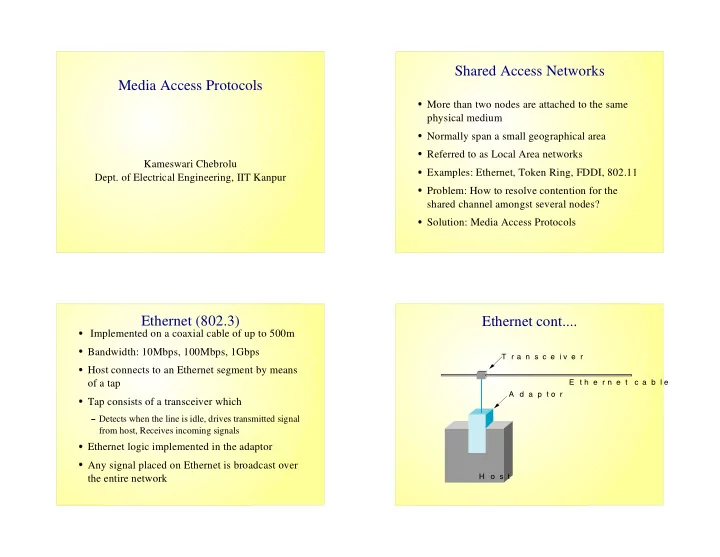

� � � � � � � � ✁ � � � � Shared Access Networks Media Access Protocols More than two nodes are attached to the same physical medium Normally span a small geographical area Referred to as Local Area networks Kameswari Chebrolu Examples: Ethernet, Token Ring, FDDI, 802.11 Dept. of Electrical Engineering, IIT Kanpur Problem: How to resolve contention for the shared channel amongst several nodes? Solution: Media Access Protocols Ethernet (802.3) Ethernet cont.... Implemented on a coaxial cable of up to 500m Bandwidth: 10Mbps, 100Mbps, 1Gbps T r a n s c e i v e r Host connects to an Ethernet segment by means of a tap E t h e r n e t c a b l e A d a p t o r Tap consists of a transceiver which Detects when the line is idle, drives transmitted signal from host, Receives incoming signals Ethernet logic implemented in the adaptor Any signal placed on Ethernet is broadcast over H o s t the entire network
✁ ✁ ✁ ✁ ✁ � ✁ � ✁ � ✁ ✁ � � � � � � Ethernet Repeater Frame Format Preamble: 64 bit sequence of alternating 0's and 1's Destination/Source Address: 48 bit address used to identify hosts Example: 00:0F:1F:D2:00:BB Type: Identifies which of the higher layer protocols this frame should be delivered 64 48 48 16 32 Repeater Dest Src Preamble Type Body CRC addr addr Host CSMA/CD Access Protocol Receiver Side Algorithm CSMA/CD: Carrier Sense Multiple Access with Collision Detection Each frame transmitted on the Ethernet is Carrier Sense means received by every adaptor connected to it All nodes can distinguish between an idle and busy link An adaptors accepts only those frames Collision Detect means addressed to its own address A node listens as it transmits addressed to the broadcast address It can detect interference from other node transmissions addressed to multicast address it belongs to Under heavy loads, utilization is only 30% all frames, if placed in promiscuous mode (special mode) Maximum hosts limited to 1024
✁ � � � � � � � ✁ � � ✁ ✁ � � � Transmitter Side Token Rings (802.5, FDDI) If the line is idle, send immediately If the line is busy, wait for it to become idle and A set of hosts connected in a ring transmit immediately (1-persistent protocol) Data flows in a particular direction around the ring If collision Each node receives from upstream neighbor and forward to downstream neighbor Jam for 32 bits and stop transmission Like in Ethernet, the ring is viewed as a single To detect collisions, minimum frame size is set to 512 bits shared medium Wait some time and try again (exponential back off) 1 st time: 0, 51.2 us Bandwidths: 4Mbps, 16Mbps or 100Mbps 2 nd time: 0, 51.2, 102.4 or 153.6 us 250 stations per Ring n th time: waits k * 51.2us, k random between 0 and 2 n - 1 Report a transmission error after 16 attempts Multistation Access Units Token Ring Network Host MSAU Host Host From previous MSAU T To next MSAU Host
� ✁ ✁ ✁ � � � ✁ ✁ � ✁ ✁ ✁ ✁ � ✁ � � ✁ ✁ ✁ � � � � � � ✁ Basic Idea Frame Format A special bit pattern (24 bit token) rotates round the Access control: Includes frame priority ring Frame Control: Identifies higher layer protocol A host must capture token before transmitting a packet Address fields: Similar to Ethernet, 48 bits long As the packet flows past each node on the ring Frame Status Byte: Provides reliability info. Only the intended receiver copies the packet into its buffer “A” bit is set if the intended recipient sees the frame Only the sending host can remove the packet from the ring “C” bit is set if the intended recipient copies the frame After finishing transmission, sending host release token into its buffer successfully back into the ring Immediate release 8 8 8 48 48 Variable 32 8 8 Delayed release Start Access Frame Dest Src End Frame Body Checksum delimiter control control addr addr delimiter status Hosts get a Round-Robin service Role of the Monitor Token Ring Maintenance Ensures that there is always a token in the ring A token can vanish due to bit errors, crash of a machine holding A host acts as a “Monitor” to ensure the health of the token the ring Monitor employs a Timer and watches for a passing token A Monitor periodically transmits a special If timer expires before the token is seen, it creates a new one control message Timer: NumStations * TokenHoldingTime + RingLatency A Monitor is elected by transmitting a “claim” Checks for corrupted or orphaned frames token They are detected using the “monitor” bit in the header Contention is broken by some well defined rule like “highest address wins” At transmission, this bit is set to 0, first time monitor sees the packet, this bit is set to 1 Monitor drains off the ring any packet with monitor bit set to 1
� � ✁ � Summary Looked at how to mediate access to a shared link Two different protocols: Ethernet CSMA/CD and token ring Protocols are distributed in nature Moving on to “How to make two hosts talk when they are not directly connected?”
Recommend
More recommend